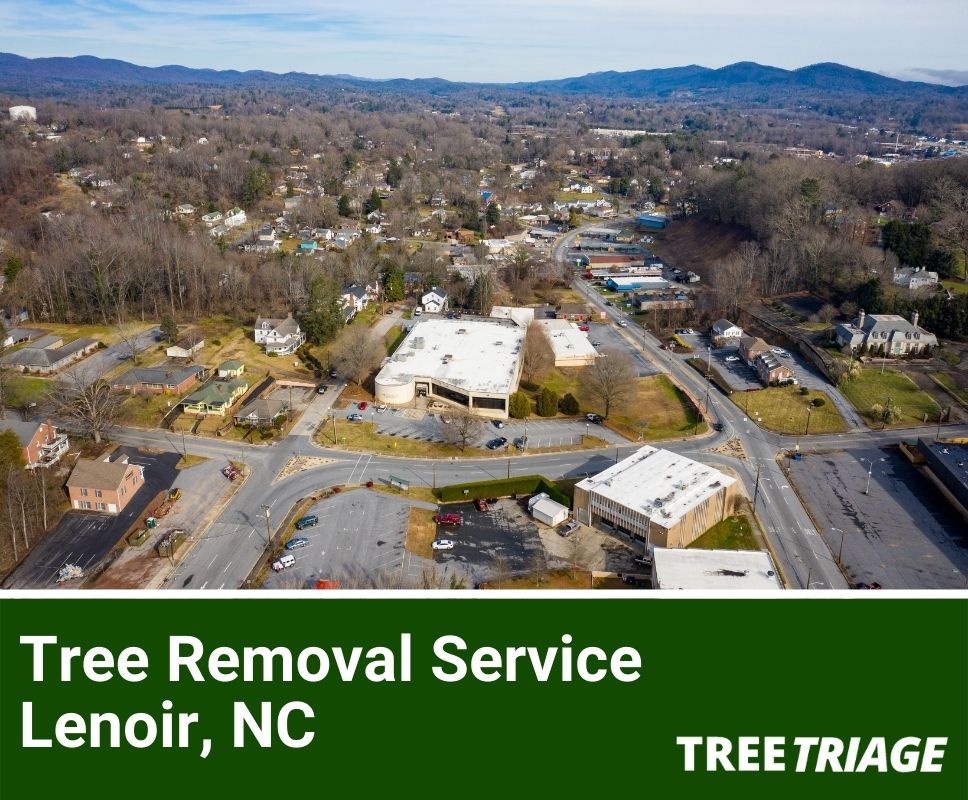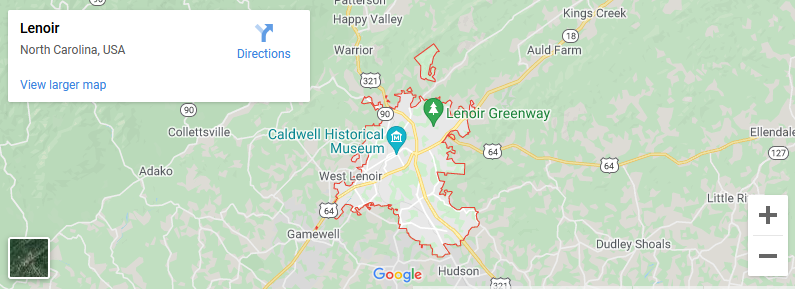Contents (Click To Jump)
- 1 What Are the Most Common Tree Issues in Lenoir?
- 2 Does the City of Lenoir Provide Any Assistance in Tree Removal Problems?
- 3 Who Is Responsible For Fallen Tree Removal in Lenoir?
- 4 How Does the Soil Affect Trees in Lenoir?
- 5 Does Weather Affect Tree Health in Lenoir?
- 6 What If Dead Trees Are Near Power Lines in Lenoir?
- 7 How Much Does Tree Removal Usually Cost in Lenoir?
What Are the Most Common Tree Issues in Lenoir?
Lenoir is an amazing city. It has the feel of a small town while still maintaining many of the amenities of a larger city. It’s produced Nobel laureates and baseball players, but perhaps it’s best known for its position at the foot of the Brushy Mountains. With mountains come trees, and with trees come tree issues. The most common of these problems are insects, which makes sense when you consider how much of the area around Lenoir is forested. Pine webworms and sawflies can eat all the leaves off a tree, but they’re not the primary concern here in Lenoir. Bark boring beetles, such as the southern pine beetle, can kill a tree in weeks and there’s very little that can be done to remove them. They burrow into the bark of trees and eat the sensitive phloem tissue underneath the bark. Not only does this cripple the tree, but they can spread a fungus called Ophiostoma minus — commonly known as the blue stain fungus — that will likewise eat away at a formerly healthy tree until all that’s left is a dead husk. After these beetles are established in a tree, there’s very little that can be done to save it, so it’s critical to monitor the health of your trees and immediately respond to any sudden changes.
Some of the other most common tree issues we find in Lenoir are diseases, including:
- Pecan tree scab (causing black or brown spots on leaves and husks)
- Anthracnose or cankers (which can cause toxic growths on injured areas of bark)
- Leaf blister (which causes blisters and cupping on leaves, especially oaks)
- White pine blister rust (a fungus that thrives at high altitudes)
- Fusiform rust (which causes a rusty appearance on tree bark)
- Annosus root rot (which can kill pines through starvation)
- Dutch elm disease (a fungus spread by beetles that kill elm trees branch by branch)
These can be caused by fungi, bacteria, viruses, or parasites. Some of these are easily treatable, while others are more persistent, so if you notice anything odd on trees you own, it’s important to contact our experts to diagnose the cause.
Does the City of Lenoir Provide Any Assistance in Tree Removal Problems?
The city of Lenoir collects some yard waste. While this is most commonly grasses and small shrubbery, city services do patrol for tree limbs and pick them up. These limbs cannot be more than 6 feet long and 4 inches in diameter, and if the pile is larger than 6 feet long, 6 feet wide, and 5 feet high, you will face a collection fee of $25.00 per scoop. Keep in mind that the thicker, cut end of each limb should face the street. Also make sure not to block any public rights of way, such as sidewalks or streets.
If you own more than 20 acres of forested land, you should reach out to the North Carolina Forest Service (the Caldwell County office phone number is 828-757-5612) and the North Carolina Cooperative Extension at 828-757-1290, as you may qualify for forestry assistance. If you do, they can help you with cost-share programs (on the state and federal level), tax issues, certification programs, and keep you up to date on environmental concerns.
Who Is Responsible For Fallen Tree Removal in Lenoir?
If you’re a homeowner?
If you own a home, you own the trees that grow on the land. This also means you own the trees that fall on the land. Whether due to wind, disease, lightning, or just old age, the old adage of “if you make a mess, you clean it up” applies to trees in Lenoir. But before you groan and vow never to plant anything again, call your homeowner’s insurance company. Nearly every home in the United States has trees, nearly every home insurance plan has language regarding trees. The costs of removing and replanting trees may be covered.
Also, remember the city’s branch removal program: if your fallen tree isn’t 100% covered but you’re handy with a saw, you may be able to save some money by taking apart the smaller branches yourself before our arborist arrives.
If you’re a renter?
If you rent your home, you technically aren’t responsible for any trees on the property. That’s your landlord’s domain. If your landlord is unresponsive or unavailable and it’s an urgent situation (one that creates immediate hazards to life and property), you may be able to hire our arborists yourself and have the cost deducted from your rent, but it’s important to check the terms of your lease to make absolutely sure that this is allowed. As a renter, you’re also the “eyes on the ground” for your landlord; you’re in the best position to see when things are starting to go wrong. It’s your responsibility to keep watch on the trees on your property and inform your landlord of any oddities or changes that occur.
If you’re a landlord?
If you’re a landlord, all the points in the “homeowner” section above apply to you as well. As a landlord, you also have the responsibility to respond quickly and appropriately to any calls your tenants have about tree-related hazards on your property. This entails both being on call to respond to urgent emergencies and being aware of your responsibilities regarding less urgent issues. If the issue is as simple as a small fallen limb, your tenants may be able to deal with it themselves. Either way, the best way to prevent emergencies from happening is to perform regular maintenance on the property and be aware of any hazards that may become relevant with time.
If you’re a neighbor?
Nothing can ignite a feud between neighbors quite like a dispute over trees. Whether you’re worried about a low-hanging branch creating a hazard or a tree that’s fallen on your property, it’s important to remain civil no matter what happens. If your property is damaged in any way, your first step should be to call your homeowner’s or renter’s insurance claims department. They can not only help defray the cost of repairs, but are crucial for determining liability if it does turn out your neighbor was negligent in any way. (Insurance companies also have teams of people whose job is to work with other insurance companies in situations like this, so calling your homeowner’s insurance can save you the trouble of finding out your neighbor’s insurer as well.) Note that in North Carolina, landowners are generally not liable for healthy branches that fall onto your property due to a severe storm or other act of God, but if they refuse to take care of their tree and that leads to damage, their insurance may have to pay up.
Also, if you see a situation that may become hazardous in the future on your neighbor’s property, speak up! Let them know what you’re worried about. Your neighbors can’t fix something they don’t realize is a problem.
How Does the Soil Affect Trees in Lenoir?
Western North Carolina is famous for its rich, healthy soils. It’s one of the reasons we have such thick forests. Most of Caldwell County’s soil is part of low and intermediate mountain systems, which provide acidic, highly weathered soil. This means that trees such as firs, mountain laurels, white oak, juniper, and spruce tend to thrive without much human intervention. There are some trees (such as green ash and silver maple) that need less acidic soil, and depending on your local conditions you may have to apply a small amount of ground limestone or some other alkaline material. In order to get your soil tested, you can purchase a kit at a hardware or garden supply store, or contact the North Carolina Cooperative Extension.
Does Weather Affect Tree Health in Lenoir?
The biggest weather event that can impact the health of trees in Lenoir is a hurricane. Even though Lenoir is nowhere near the coast, a major storm can continue to produce hurricane-force gusts of wind more than 150 miles inland, potentially toppling trees and sending branches flying as the cyclone dissipates. Additionally, all the rain has to go somewhere! While having lots of greenery in an area reduces soil erosion, hurricane-level rains can remove topsoil and leave older trees exposed and vulnerable to rot. Nobody may be able to prevent a hurricane, but keeping watch on your trees afterward can help them — and the ecosystem — recover.
What If Dead Trees Are Near Power Lines in Lenoir?
Blue Ridge Energy is responsible for ensuring that everybody in the area has access to power, and they do quite a lot of preventative maintenance on trees in their rights-of-way. These are the areas within 15 to 30 feet of the distribution power lines they own, and that range extends to 250 feet for the large transmission lines. Every six years, you can expect BRE to come by to trim the plants that are encroaching onto their rights-of-way, and treat particular problem plants with herbicide a year later. Three years later they do a “mid-cycle trim” in which they clear dead trees that have become hazardous. They’ve even started using helicopters for tree removal in some cases. That said, you can contact them year-round at 1-800-632-4949 to report a hazard condition such as a dead tree near a power line, as they do remove these year-round if they are reported quickly. If BRE has to remove a tree on your property, you may also qualify for a voucher to a local nursery in order to replace it with a different, lower-growing species.
How Much Does Tree Removal Usually Cost in Lenoir?
Removing a fully-grown tree never comes cheaply, and in Lenoir removing a tree can run anywhere from $150 to more than $1000. This is due to a variety of factors, some of which are listed here.
Tree Size
The first question any arborist will ask about removing a tree is how tall it is. Trees under 20 feet tall can be removed at less cost than taller trees, and you’re likely to fall closer to the $150 end of the earlier estimate. Trees taller than 60 feet are generally much more expensive, as they require heavier equipment and present more safety hazards to the fallers, and will be closer to the $1000 side of the spectrum.
Accessibility
Our arborists can only remove trees using the equipment they can get to the site. In practice, this can mean that trees that are very close to a building, near power lines, other trees, or have limited falling room can cost more, as it’s harder to get equipment where it needs to be. If the tree’s already fallen and it’s on a structure, this too will increase the cost of removal, as more specialized equipment is needed to avoid damaging your home further.
Time
If a tree falls in Lenoir and nobody’s around to hear it, removing it will probably be less expensive than if it falls on top of your car and you need it removed right away. Urgent calls will always come at a premium, as will calls during the busy seasons (summer and autumn). The longer it takes to reach the tree, the more you can expect to pay as well.






